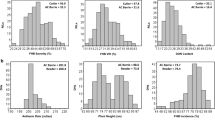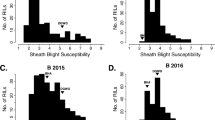Abstract
F2:3 families from crosses between three rice indica introgression lines and their common japonica recurrent parent were used to evaluate two quantitative trait loci (QTL) for sheath blight (SB) resistance. Three selected TeQing-into-Lemont backcross introgression lines (TILs) were more resistant than their susceptible parent (Lemont) in inoculated field plots, and were molecularly verified to contain TeQing alleles at qSB9-2 and/or qSB12-1. F2 individuals homozygous for qSB9-2 and qSB12-1 provided F2:3 families that fit four genotypic classes: containing the resistant TeQing allele for qSB9-2 TQ alone, qSB12-1 TQ alone, both qSB9-2 TQ and qSB12-1 TQ , and neither SB QTL introgression. By comparing the SB resistance of these four genotypic classes in micro-chamber evaluations and inoculated field plots, the phenotypic values of the QTL were measured. Under both study conditions, disease resistance ranked qSB9-2 + qSB12-1 > qSB9-2 > qSB12-1 > no QTL, with both qSB9-2 and qSB12-1 acting as dominant resistance genes. In micro-chamber studies, qSB9-2 TQ reduced disease an average of 1.0 disease index units and qSB12-1 TQ by 0.7 using a scale of 0–9. Field effects of qSB9-2 TQ and qB12-1 TQ were less pronounced, with average phenotypic gains of 0.5 and 0.2 units, respectively. TIL:642 proved to contain qSB9-2 TQ in an introgression so small it was tagged by just RM205 on the tip of chromosome 9. These studies verify that the indica introgression of qSB9-2 TQ or qSB12-1 TQ can measurably improve resistance to sheath blight disease in a highly susceptible tropical japonica cultivar, and fine-mapped the qSB9-2 locus. Markers presently verified as linked to these QTL can support marker-assisted breeding to improve disease resistance.
Similar content being viewed by others
Abbreviations
- CSSL:
-
Chromosome segment substitution line
- LSM:
-
Least squared mean
- MAS:
-
Marker-assisted selection
- Mbp:
-
Mega base pair
- QTL:
-
Quantitative trait locus/loci
- RIL:
-
Recombinant inbred line
- SB:
-
Sheath blight
- SBR:
-
Sheath blight resistance
- SSR:
-
Simple sequence repeat
- TIL:
-
TeQing-into-Lemont introgression line (equivalent to chromosome segment substitution line)
References
Adam GC (1988) Thanatephorus cucumeris (Rhizoctonia solani) a species of wide host range. In: Sidhu GS (ed) Advances in plant pathology, vol 6. Genetics of plant pathogenic fungi. Academic Press, New York, NY, pp 535–552
Belmar SB, Jones RK, Starr JL (1987) Influence of crop rotation on inoculum density of Rhizoctonia solani and sheath blight incidence in rice. Phytopathology 77:1138–1143
Chen ZX, Zhou JH, Xu JY, Tong YH, Tang SZ, Wang ZB, Jing RM, Ling B, Tang J, Pan XB (2000) A preliminary study on resources of resistance to rice sheath blight. Chin J Rice Sci 14:15–18
Damicone JP, Patel MV, Moore WF (1993) Density of sclerotia of Rhizoctonia solani and incidence of sheath blight in rice fields in Mississippi. Plant Dis 77:257–260
Eizenga GC, Lee FN, Rutger JN (2002) Screening Oryza species plants for rice sheath blight resistance. Plant Dis 86:808–812
Fjellstrom RG, McClung AM, Shank AR (2006) SSR markers closely linked to the Pi-z locus are useful for selection of blast resistance in a broad array of rice germplasm. Mol Breed 17:149–157
Fu D, Chen L, Yu G, Liu Y, Lou Q, Mei H, Ziong L, Li M, Xu X, Luo L (2011) QTL mapping of sheath blight resistance in a deep-water rice cultivar. Euphytica 180:209–218. doi:10.1007/s10681-011-0366-5
Han YP, Xing YZ, Chen ZX, Gu SL, Pan ZB, Chen XL, Zhang QF (2002) Mapping QTLs for horizontal resistance to sheath blight in an elite rice restorer line, Minghui 63. Acta Genet Sinica 29:565–570
Jia Y, Correa-Victoria FJ, McClung AM, Zhu L, Liu G, Wamishe Y, Xie J, Marchetti MA, Pinson SRM, Rutger JN, Correll JC (2007) Rapid determination of rice cultivar responses to the sheath blight pathogen Rhizoctonia solani using micro-chamber screening method. Plant Dis 91:485–489
Kunihiro Y, Qian Q, Sato H, Teng S, Zeng DL, Fujimoto K, Zhu LH (2002) QTL analysis of sheath blight resistance in rice (Oryza sativa L.). Acta Genet Sin 29:50–55
Li ZK, Pinson SRM, Marchetti MA (1995) Characterization of quantitative trait loci (QTLs) in cultivated rice contributing to field resistance to sheath blight (Rhizoctonia solani). Theor Appl Genet 91:382–388
Liu YF, Chen ZY, Ji JA, Liu YZ (2006) Analysis of resistance to sheath blight on the commercial cultivars and new potential breeding lines of Jiangsu Province. Jiangsu Agric Sci 1:27–28
Liu G, Jia Y, Correa-Victoria FJ, Prado GA, Yeater KM, McClung AM, Correll JC (2009) Mapping quantitative trait loci responsible for resistance to sheath blight in rice. Phytopathology 99:1078–1084
Loan LC, Du PV, Li Z (2004) Molecular dissection of quantitative resistance of sheath blight in rice (Oryza sativa L.). Omonrice 12:1–12
Marchetti MA, Bollich CN (1991) Quantification of the relationship between sheath blight severity and yield loss in rice. Plant Dis 75:773–775
Mew TW, Collyn B, Pamplona P (2004) Applying rice seed-associated antagonistic bacteria to manage rice sheath blight in developing countries. Plant Dis 88:557–564
Ou SH (1985) Rice diseases, 2nd edn. Commonwealth Mycological Inst, Kew
Pan XB, Rush MC (1997) Studies in the U.S. on genetics and breeding of resistance to rice sheath blight. J Jiangsu Agric Coll 18:57–63
Park DS, Sayler RJ, Hong YG, Nam MH, Yang YN (2008) A method for inoculation and evaluation of rice sheath blight disease. Plant Dis 92:25–29
Pinson SRM, Capdevielle FM, Oard JH (2005) Confirming QTLs and finding additional loci conditioning sheath blight resistance in rice (Oryza sativa L.) using recombinant inbred lines. Crop Sci 45:503–510
Pinson SRM, Oard JH, Groth D, Miller R, Marchetti MA, Shank AR, Jia MH, Jia Y, Fjellstrom RG, Li Z (2008) Registration of TIL:455, TIL:514, and TIL:642, three rice germplasm lines containing introgressed sheath blight resistance alleles. J Plant Reg 2:251–254
Pinson SRM, Liu G, Jia MH, Jia Y, Fjellstrom RG, Sharma A, Wang Y, Tabien RE, Li Z (2011) Registration of a rice gene mapping population consisting of ‘TeQing’-into-‘Lemont’ (TIL) backcross introgression lines. J Plant Reg (submitted)
Rush MC, Lee FN (1992) Sheath blight. In: Webster RK, Gunnell PS (eds) Compendium of rice diseases. APS Press, St. Paul, pp 22–23
SAS Institute (2004) The SAS system for windows, V 9.1.3. SAS Inst, Cary
Sato H, Ideta O, Audo I, Kunihiro Y, Hirabayashi H, Iwano M, Miyasaka A, Nemoto H, Imbe T (2004) Mapping QTLs for sheath blight resistance in the rice line WSS2. Breed Sci 54:265–271
Savary S, Castilla NP, Elazegui FA, McLaren CG, Ynalvez MA, Teng PS (1995) Direct and indirect effects of nitrogen supply and disease source structure on rice sheath blight spread. Phytopathology 85:959–965
Sharma A, McClung AM, Pinson SRM, Kepiro JL, Shank AR, Tabien RE, Fjellstrom RG (2009) Genetic mapping of sheath blight resistance QTLs within tropical japonica rice cultivars. Crop Sci 49:256–264
Srinivasachary, Willocquet L, Savary S (2011) Resistance to rice sheath blight (Rhizoctonia solani Kühn) [(teleomorph: Thanatephorus cucumeris (A.B. Frank) Donk.] disease: current status and perspectives. Euphytica 178:1–22
Tang JB, Ma BT, Wang LZ, Li P, Zheng AP, Chen H (2002) Biological control of rice sheath blight with Trichoderma. Chin J Rice Sci 16:63–66
Wamishe YA, Jia Y, Singh P, Cartwright RD (2007) Identification of field isolates of Rhizoctonia solani to detect quantitative resistance in rice under greenhouse conditions. Agric Chin 1:361–367
Xie XW, Xu MR, Zang JP, Sun Y, Zhu LH, Xu JL, Zhou YL, Li ZK (2008) Genetic background and environmental effects on expression of QTL for sheath blight resistance in reciprocal introgression lines of rice. Acta Agron Sin 34:1885–1893
Zou JH, Pan XB, Chen ZX, Xu JY, Lu JF, Zhai WX, Zhu LH (2000) Mapping quantitative trait loci controlling sheath blight resistance in two rice cultivars (Oryza sativa L.). Theor Appl Genet 101:569–575
Zuo SM, Yin YJ, Zhang L, Zhang YF, Chen ZX, Pan XB (2007) Breeding value and further mapping of a QTL qSB-11 conferring the rice sheath blight resistance. Chin J Rice Sci 21:136–142
Zuo S, Zhang L, Wang H, Yin Y, Zhang Y, Chen Z, Ma Y, Pan X (2008) Prospect of the QTL-qSB-9Tq utilized in molecular breeding program of japonica rice against sheath blight. J Genet Genomics 35:499–505
Acknowledgments
This research was supported in part by the USDA Cooperative State Research, Education and Extension Service—National Research Initiative—Applied Plant Genomics Program entitled “RiceCAP: A coordinated research, education, and extension project for the application of genomic discoveries to improve rice in the United States” (USDA/CSREES grant 2004 35317 14867). The authors thank Ms. Piper Roberts, pathology technician at the USDA-ARS Rice Research Unit, Beaumont, TX for field plot management and disease ratings.
Author information
Authors and Affiliations
Corresponding author
Rights and permissions
About this article
Cite this article
Wang, Y., Pinson, S.R.M., Fjellstrom, R.G. et al. Phenotypic gain from introgression of two QTL, qSB9-2 and qSB12-1, for rice sheath blight resistance. Mol Breeding 30, 293–303 (2012). https://doi.org/10.1007/s11032-011-9619-1
Received:
Accepted:
Published:
Issue Date:
DOI: https://doi.org/10.1007/s11032-011-9619-1




